Excerpts from Jim Conrad's
Naturalist Newsletter
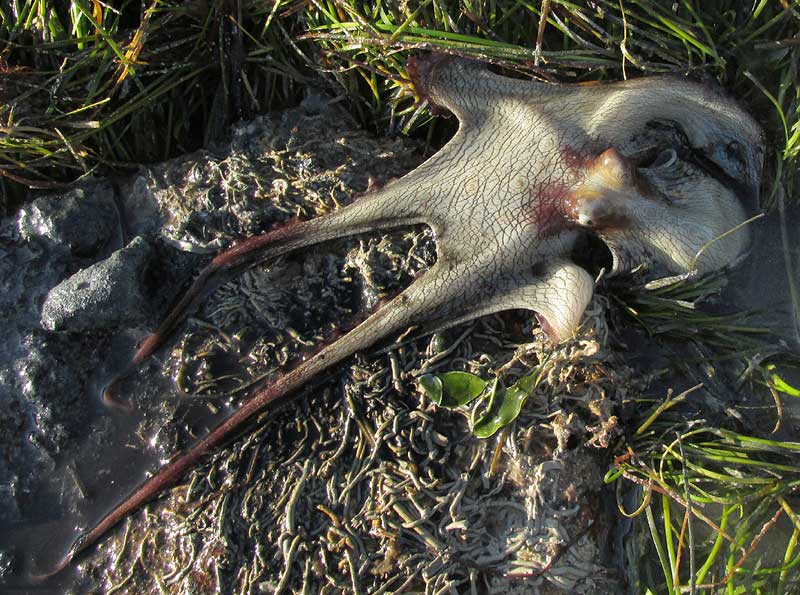
from the February 22, 2015 Newsletter issued from Río Lagartos, on the Yucatan Peninsula's northern coast (~N21.60°, ~W88.16°), Yucatán state, MÉXICO
MEXICAN FOUR-EYED OCTOPUS
At low tide a small slab of concrete lying on normally submerged mud was turned over, revealing the strange object shown below:
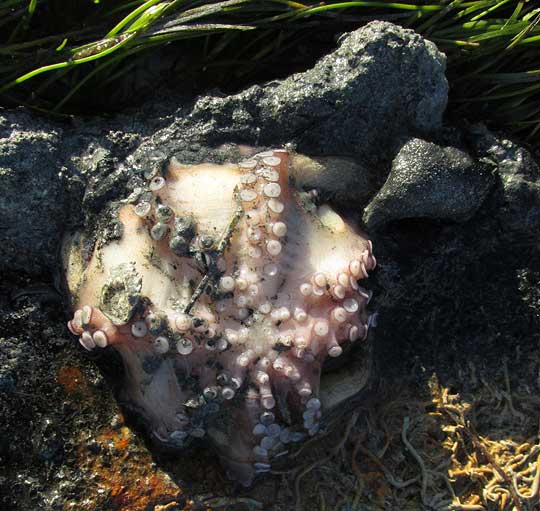 .
.
"¡Pulpo!" Rayo exclaimed, the name translating to "octopus," though the baseball-size thing didn't look like an octopus to me. I started to poke the discovery with my finger but Rayo held back my hand saying I might get bitten. Then he inserted his own fingers below the object and began prying it from the concrete. Once the creature was half unstuck, its octopus nature became more apparent, and I could see that we'd been looking at the octopus's upside-down bottom, its eight arms being curled over and under the main part of its body. Below, you can see the half-unstuck octopus:
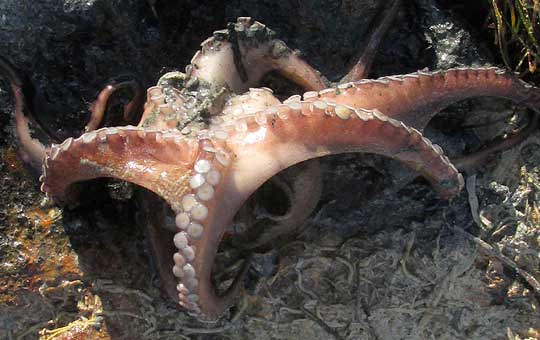
Once the octopus flipped itself right side up, it took shape, its two big eyes bulging atop its "head," as shown at the top of this page.
If you're unaccustomed to the octopus manner of being, it may seem that the main part of the octopus body is the broad, flat area to the left of the eyes, and that the fleshy blob at the eyes' right is something like a very large nose with flaring nostrils, but it's the other way around. The fleshy item on the right is the body containing stomach, intestines, liver, gills, kidney and such, while the broad, flat area to the eyes' left is just a web of tissue stretched between the front arms. In that picture, the octopus is moving from right to left, or "forward," with the body being pulled along behind.
A close-up showing the animal's pretty skin and color patterns is shown below:
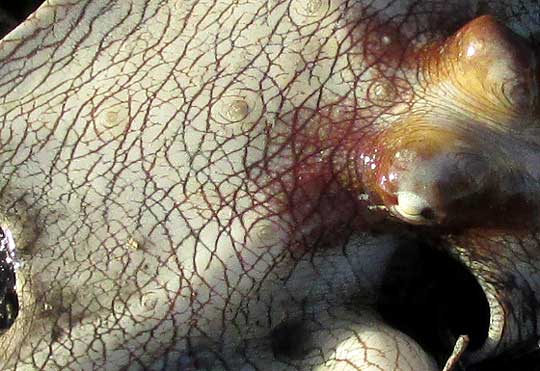
Rayo couldn't restrain himself from lifting up the octopus for a better view, shown below:
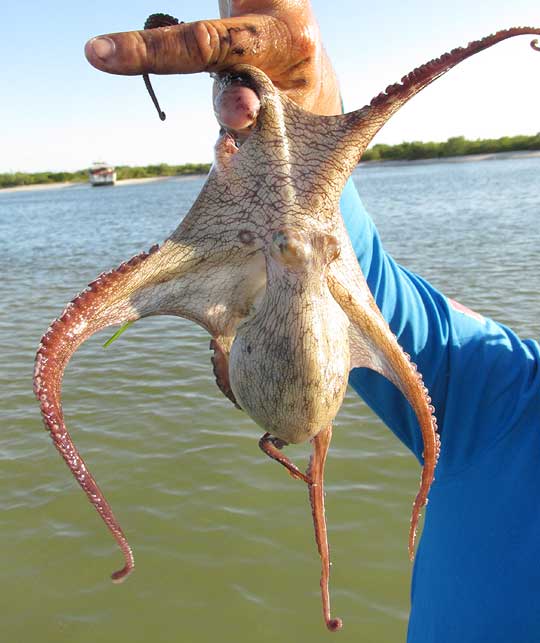
A close-up of the center area of the octopus's bottom showed mushroom-like suction cups on the arms' lower surfaces, seen below:
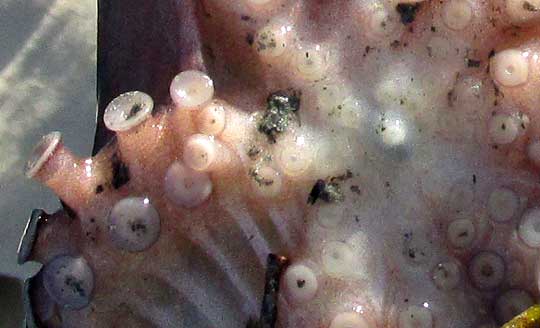
As Rayo handled the creature, its arms constantly wrapped around his hands, with the suction cups latching onto his skin. When he pulled the arms loose, it sounded like Velcro being ripped off. In the above picture, at the right of the picture, in the center of the area without suction cups, notice the slightly dark bulge in the area's center. That's the octopus's birdlike beak withdrawn so that it's hardly visible, and that's what Rayo had been afraid I'd poke and get bitten with. It also explains why Rayo had felt comfortable sliding his fingers beneath the blob stuck to the concrete, for there's no beak on that side. Remember that the concrete slab had been flipped over, so before we came the octopus's bottom with its beak had been directed toward the mud floor, and the slab had been his ceiling.
Judkins et al in their 2009 "Checklist of Cephalopods from the Gulf of Mexico" lists fourteen species in the Octopus Family, the Octopodidae, found in the Gulf of Mexico. Of these, two species are commonly encountered in waters of the Yucatan Peninsula. One is the Common Octopus, Octopus vulgaris, of nearly worldwide distribution, and the other is the endemic Octopus maya, known in the literature as the Mexican Four-eyed Octopus. Locally, Octopus vulgaris is known as "Pulpo Patón," while Octopus maya is "Pulpo Rojo," the word "rojo" meaning red, and referring to the mollusk's reddish body. During octopus fishing season about 80% of the Yucatan's catch is of Octopus maya, while only 20-30% is Octopus vulgaris. So, which species do we have?
Distinguishing the two species can be hard for beginning octopus identifiers, especially because individuals of both species change color drastically,the color schemes between species overlaps a good bit, and the shapes of individuals is so changeable that it's hard to say what's the "real shape." After speaking with the most experienced octopus fishermen in my neighborhood, and showing them our pictures, the consensus is that our octopus is the Mexican Four-eye, Octopus maya.
My impression is that the best field mark for separating the two species is that the Common Octopus's body is thickly pear-shaped, almost spherical, while that of our Octopus maya is more compressed. In our pictures, much of the body's width when seen from above is provided by flaps of tissue flaring from the bulging part of the body. And that bulging part is much longer than broad, not almost spherical, as with the Common's.
Bottom-dwelling octopuses such as Octopus maya mainly feed on crabs, polychaete worms, and their fellow mollusks such as whelks and clams.
Octopuses in general are regarded as possibly more intelligent than any other order of invertebrate. Maze and problem-solving experiments have suggested a memory system that can store both short- and long-term memory.
The February 18, 2015 issue of the online "Diario de Yucatán" reports that in 2014 more than 22,000 metric tons (24.250 US short tons) of octopus were caught in waters of the Yucatan Peninsula. When I recall how many boats went out during harvesting season, and how many trucks filled with refrigerated octopus bodies passed by my door, I don't doubt the numbers at all, and wonder how long such exploitation can last.
from the May 24, 2015 Newsletter issued from Río Lagartos, on the Yucatan Peninsula's northern coast (~N21.60°, ~W88.16°), Yucatán state, MÉXICO
OCTOPUS IN A SEA CUCUMBER GUT
During the current sea-cucumber season boats fishing several miles offshore normally are manned like this: One person is on the sea floor gathering up sea-cucumbers; another sits at the motor keeping the boat positioned properly, and; the third person hauls up sea-cucumbers in bags from below, cuts the animals across their bellies, and removes their stringy intestines -- which can be surprisingly long -- and throws them overboard.
Rayo, or Diego Jr., was handling the latter job when he cut open a sea-cucumber and found inside what's shown below in his picture taken at sea with a cell phone:
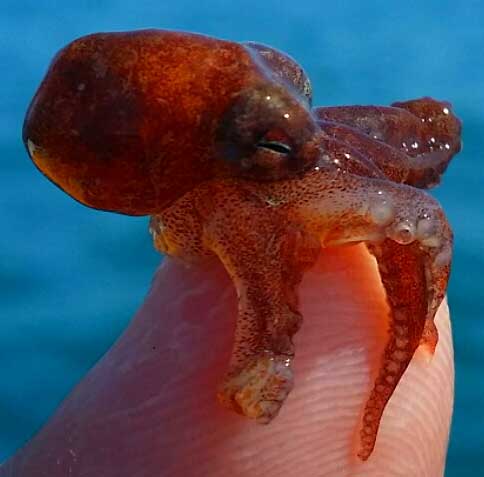
It's a partially digested octopus, though it's too young for me to figure out which species it is.
The National Wildlife Federation says that sea-cucumbers feed on algae, aquatic invertebrates, and waste particles, so now we know that some of those aquatic invertebrates can be as large as a baby octopus.